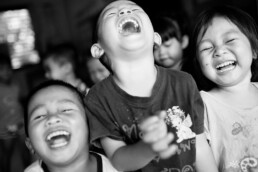Laos
Laos is an ancient kingdom that for centuries had great influence in Southeast Asia. Later it was dominated by Thailand until the 19th century, when it became part of French Indochina.
In 1975, the Communist Party of Pathet Lao took control of the country and introduced a strict socialist regime in close cooperation with Vietnam. A gradual and partial privatization of business and the liberalization of foreign investment began in 1988. Laos joined the WTO in 2013.
Laos holds a tragic record. During the Vietnam War in the 1960s and 1970s, hundreds of millions of bombs were dropped on Laos.
Today, most bomb craters are hidden under grass, but a few inches below the ground are still millions of unexploded mines. Laos’ national mine clearing organization, UXO Laos, estimates that more than 50 people die or are injured each year due to mines. More children than adults are injured because children confuse the small, round mines with toys.
Economic growth of seven percent a year has helped many Laotians out of poverty, but there is still a long way to go to World Goal 1, which states that extreme poverty must be completely abolished so that no one has to live for less than the previous international poverty line of 1.25 dollars a day.
Men, women and children are thus forced to work in factories, in agriculture, in the fishing industry or in the sex industry, and the situation also leads to trafficking in people both in and out of the country.
Therefore, Laos must make an effort to achieve World Goal 8 on decent work for all. The country must take effective action to put an end to forced labor, modern slavery and human trafficking. At the same time, the worst forms of child labor must be abolished, while all forms of child labor must go away by 2025.
Children in Laos
In many aspects, Laos does not live up to the UN Convention on the Rights of the Child. Ten percent of all children between the ages of five and 14 are child workers, and as many as 76 percent of all children between the ages of 2 and 14 in Laos are exposed to physical or psychological violence from adults in their homes.
Girls are discriminated against in many ways in Laos. Teenage mothers often end up interrupting their education. This applies not least to girls from minority groups, and girls who live in the countryside, where the infrastructure is poor and there is a long way between schools, clinics and other public services. Thousands of girls are sold into prostitution every year.
SOS Children’s Villages has been working near the capital Vientiane since 1993 and has over time expanded its work to include Luang Prabang, Pakse, Samneua, Savannakhet and Xiengkhouang.

Facts about children
- 34 percent of the population is under 14 years of age.
- 85,000 or 3.5 percent of children under the age of 15 have lost one or both parents.
- Nearly 67 children out of 1,000 die before the age of five.
- 97 percent of all children start in 1st grade, but on average, only 85 percent attend elementary school every day, and only 73 percent of the children who start in 1st grade reach 5th grade. Only 45 percent continues further.
- 44 percent of all children do not develop as they should due to malnutrition.
- 58 percent of all children under 5 years of age are not treated for dehydration if they have diarrhea.
Country facts
- There are more than 6.8 million people living in Laos.
- A laot earns an average of 1,840 euro a year or 5 euro a day.
- 0.3 percent of all Laotians between the ages of 15 and 49 live with HIV or AIDS.
- For every 100,000 children born, 197 Laotian women die from complications during pregnancy or childbirth.
- The birth rate is just over 27 live-born children per 1,000 laoter.
- A Laotian woman can expect to live for 68 years and a man for 65 years.
- Just over 17 percent of the population lives below the $ 1.90 poverty line per day.
Village communities in Laos
Support MY FOUNDATION's work in Laos, or become a partner in a project or a village community in the country.